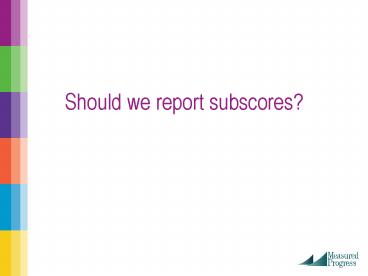Should we report subscores
1 / 20
Title: Should we report subscores
1
Should we report subscores?
2
Outline
- Subscore as Skills Diagnostic information
- Cognitive Diagnostic Models (CDMs)
- Dimensionality Analysis
- Classical Test Theory based subscore analysis
- Analysis of Classification Accuracy based on
synthesized empirical data
3
Subscores as Skills Diagnostic information
- Why use subscore?
- Can provide more useful information about
teaching and learning - Example
- Rather than reporting Candy being in the 80th
percentile in statistics - Report Candy is proficient in multivariate
analysis, experimental design, but needs to work
on time series, sampling. - Follow up such profile with quality
individualized instruction for Candy.
4
Cognitive Diagnostic Models
- Fusion model
- Simplified from Unified model (DiBello et al.,
1995) - Good side
- Can link the observable performance to latent
skills specified by expert/theory/previous
experience (Q-matrix) - Limitation
- Estimation
- Parameters can be estimated using Hierarchical
Bayesian approach (Arpeggio).
5
Dimensionality Analysis
- To find the dimension structure of the test
- DETECT and NOHARM
6
Classical Test Theory based subscore analysis
- Goal To predict the true subscore from the
observed score - Predictors of true subscore
- Observed subscore
- Observed total score
- To report subscore in a test?
7
Method Classical Test Theory
- Habermans Method (Haberman, 2008)
- Proportional Reduction in MSE (PRMSE)
8
Research Questions
- Q1
- Can raw subscore obtain comparative student skill
profiles as fusion model does? - Q2
- Can four subscores (observed subscore, mastery
probability, and expected subscores based on CTT,
MLE of ?) produce comparative classification
accuracy?
9
Analysis procedure for Q1
- Step 1 Dimensionality analysis
- Step 2 Cluster analysis
- Derive profiles based on raw subscores,
transformed raw subscores, and mastery
probability - Step 3 Comparison of profiles by cluster analysis
10
Data
- Sample size 14874
- Number of subtests 3
- Content area Mathematics, Reading, Science
11
Results of Dimensionality Analysis
- DETECT
- DETECT index 0.22
- NOHARM
- Correlation between dimensions
12
Results of Cluster analysis (NOT in same scale)
- Comparison of cluster solutions
13
Results of Cluster analysis ( in same scale)
- Comparison of cluster solutions
14
Analysis procedure for Q2
- Step 1 Set the cutting scores based on ?cuts
- Step 2 Compute the subscores from each method
- Observed subscore (obs)
- Expected subscore based on either observed
subscore or total score (hab) - Maximum-likelihood estimation of ?(mle)
- Posterior probability of mastery (fus)
- Step 3 Classify students to be proficiency or
not based on the cutting scores - Step 4 Calculate the exact agreement among the
classifications of each method
15
Haberman (2007) analysis based upon Classical
Test Theory
- Summary statistics for Subscores
16
Analysis of mastery/non-mastery classification
- Classification for Math
17
Analysis of mastery/non-mastery classification
- Classification for Reading
18
Analysis of mastery/non-mastery classification
- Classification for Science
19
Summary of Classification analysis
20
Future Study
- Simulation study 1 How does dimension structure
affect the similarity of profiles based on raw
subscore and mastery probability? - Study 2 Can the standard setting information
enhance the classification accuracy of fusion
model?















![[Latest Update] CompTIA CAS-004 Actual Exam Practice Questions Shared Online](https://s3.amazonaws.com/images.powershow.com/10140958.th0.jpg?_=20240927015)















